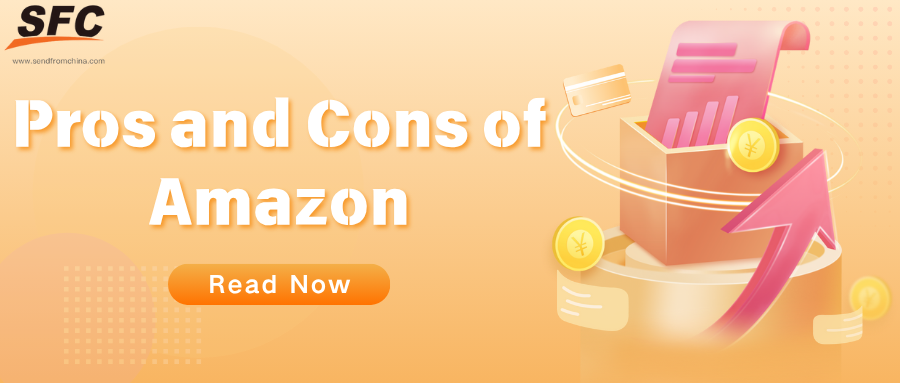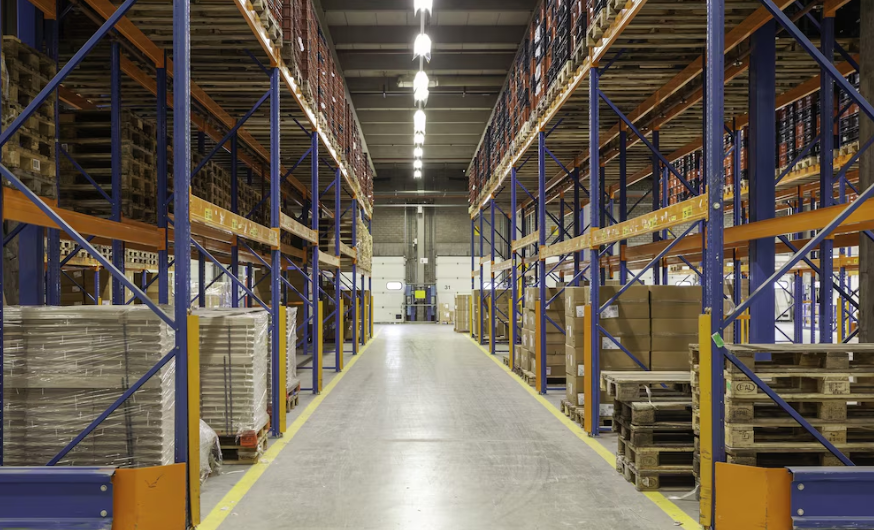Table of Contents
Pros and Cons of Amazon: Is it Still Worth Selling on Amazon in 2026?
Time: Aug 08,2025 Author: SFC Source: www.sendfromchina.com
E‑commerce’s gravitational center continues to orbit Amazon. With an estimated 36–40% share of the U.S. online retail market, Amazon remains a commanding choice for sellers seeking visibility and scale. As of 2025, approximately 82% of Amazon sellers rely on FBA (Fulfillment by Amazon), leveraging its fulfillment infrastructure to remove logistical friction and gain a competitive edge.But jumping onto Amazon—especially as a third‑party seller—is no walk in the park. The promise of fast fulfilment and “Prime‑speed” delivery often comes coupled with rising fees, fierce competition, and growing pressure on branding and margins. Recent data shows FBA and related fulfillment costs increasing steadily through 2025, while marketplace competition pushes sellers to sharpen every part of their game.
In this guide, we’ll dive into all sides of the Amazon seller journey—from the bold advantages to the hidden blind spots. You’ll hear real seller voices, understand when Amazon still shines (and when it doesn’t), and see exactly how SendFromChina’s logistics and 3PL expertise can tilt the odds in your favor—whether you're onboarding FBA, managing cross-border shipments, or seeking strategic flexibility.
Let’s get started.

1. Pros of Selling on Amazon
When it comes to e‑commerce, Amazon continues to be the gold standard—and for compelling reasons. Let’s unpack what makes it such a powerful launchpad for sellers, from unparalleled reach to cutting-edge tools you can’t easily replicate elsewhere.Unmatched Reach to Millions of Ready-to-Buy Customers
Amazon brings you to the doorstep of hundreds of millions of active shoppers worldwide. In fact, as of late 2024, Amazon boasted over 3.6 billion monthly visitors, putting your product directly in the path of millions already in purchasing mode rather than passive browsing.Many customers begin their product searches on Amazon instead of Google, attracted by the ease of the platform and reliable delivery—making it a critical traffic source.
Built-in Trust and Reporting Credibility
New sellers often wrestle with credibility—but Amazon sidesteps the hurdle. Its chosen association lends instant legitimacy to your listings. The platform’s enforced policies, robust return system, and visible reviews foster confidence that builds conversion and repeat business.Add the “Prime” badge with FBA (Fulfillment by Amazon), and buyers know your product ships fast—reliability that matters.
Logistics Made Easy—So You Can Focus on Growth
Selling online often means juggling inventory, shipping, customer service… the list never ends. But with FBA, Amazon takes over: storage, packing, shipping, returns—you name it, they handle it.This frees you up to invest time where it matters: business strategy, product growth, sourcing, and marketing—not logistics.
Powerful Seller Tools & Advertising Made Simple
Amazon doesn’t just host your listings—it equips you to grow them. Within Seller Central, you get access to training through Seller University, tools like Brand Registry for intellectual property protection, and ad platforms such as Sponsored Products, Brands, and DSP to help you target customers smartly.These tools aren’t just flashy add-ons—they’re engines for visibility, trust, and conversion.
Tap into Prime Customers & Faster Sales Velocity
FBA products automatically qualify for Prime shipping, unlocking access to a large, loyal customer base that values speed and convenience.Additionally, FBA items often get priority in search rankings thanks to Amazon’s A10 algorithm, giving you visibility—and potential sales—over FBM listings.
International Expansion—Simplified and Scalable
If you’re thinking global, Amazon handles the heavy lifting. With localized marketplaces across multiple countries, you can extend reach without needing multiple storefronts or clunky international shipping setups.Data-Driven Insights Power Smarter Growth
Amazon’s backend delivers insights—not just sales data, but keywords, conversion rates, search queries, and more. With that insight, sellers can strategically optimize listings, adjust pricing, refine ads, and respond agilely to trends.Fast & Easy Setup—From Zero to Live in Hours
Want to test an idea or launch quickly? Amazon makes it intuitive—set up shop, upload listings, and go live in a few hours. You don’t need a custom site or steep technical know-how.2. Cons of Selling on Amazon
While Amazon offers significant opportunities for third-party sellers, it's essential to weigh the challenges before committing to the platform. In 2025, many sellers are facing increased difficulties that can impact profitability and business stability.
Rising Fees and Diminishing Margins
Amazon's fee structure has become increasingly complex and costly. Sellers often encounter:- Fulfillment by Amazon (FBA) Fees: These include storage and fulfillment charges, which have risen steadily. During peak seasons, storage fees can escalate, affecting profit margins.
- Referral Fees: Amazon charges a percentage of each sale, varying by category. These fees can significantly reduce earnings.
- Advertising Costs: To gain visibility, sellers often invest in Amazon Ads, adding another layer of expense.
Collectively, these fees can consume a substantial portion of a seller's revenue, sometimes totaling 30-40% of the product price.
Intense Competition and Price Undercutting
With millions of sellers on the platform, standing out becomes challenging. Sellers face:- Price Wars: To remain competitive, many reduce prices, leading to razor-thin margins.
- Copycat Products: Competitors may replicate successful products, offering them at lower prices, further squeezing margins.
This "race to the bottom" can be detrimental, especially for small businesses trying to maintain profitability.
Account Suspensions and Policy Enforcement
Amazon's policies are stringent, and violations—intentional or accidental—can lead to:- Account Suspensions: Sellers may find their accounts suspended without prior notice, halting sales and revenue.
- Listing Removals: Products can be delisted due to policy infractions, affecting sales and brand reputation.
These enforcement actions can be particularly challenging for sellers without dedicated compliance teams.
Inventory Management Challenges
Managing inventory on Amazon involves complexities:- Storage Fees: Long-term storage fees can accumulate, especially for slow-moving products.
- Receiving Delays: During peak seasons, delays in Amazon's receiving process can prevent products from being listed promptly.
- Lost or Damaged Goods: Discrepancies between seller records and Amazon's inventory can lead to financial losses.
Competition from Amazon's Own Products
Amazon's private-label products, such as Amazon Basics, directly compete with third-party sellers. These Amazon-branded products often:- Receive Preferential Placement: They may be featured prominently in search results.
- Leverage Seller Data: Amazon has access to third-party seller data, which can inform its product development.
This dual role of Amazon as both a marketplace operator and a competitor creates inherent conflicts of interest.
Branding Limitations
While Amazon provides tools for branding, sellers face constraints:- Limited Customization: Sellers have limited control over the customer experience and brand presentation.
- Customer Loyalty: Amazon's platform emphasizes product discovery over brand loyalty, making it challenging for sellers to build a dedicated customer base.
These limitations can hinder long-term brand development and customer retention.
Legal and Regulatory Risks
Sellers must navigate various legal challenges:- Intellectual Property Issues: Unauthorized sellers may list counterfeit or trademark-infringing products.
- Regulatory Compliance: Adhering to local and international regulations can be complex, especially for global sellers.
Failure to comply can result in penalties, legal disputes, or account suspensions.
Dependence on Amazon's Ecosystem
Relying solely on Amazon for sales can be risky:- Platform Changes: Algorithm updates or policy changes can impact product visibility and sales.
- Fee Increases: Unanticipated fee hikes can erode profit margins.
Diversifying sales channels is essential to mitigate these risks and ensure business stability.
3. Is Amazon Still Popular in 2026?
Let’s fast-forward: Is Amazon still a dominant platform heading into 2026? The data says yes.
- Market leadership endures – Amazon is still the U.S. e‑commerce leader, poised to maintain over 40 % market share through at least 2027.
- Innovation and investment – Amazon keeps investing in automation, with FedEx expanding delivery roles, plus infrastructure upgrades backed by massive tax‑savings via recent legislation.
- E‑commerce resilience – Even amid broader economic pressures, consumer spending on platforms like Amazon and Etsy remains strong, with Amazon’s North American sales up 11 % in the latest quarter.
- Prime growth on the horizon – Prime membership is expected to reach approximately 350 million in 2025, with a planned membership price increase in 2026 unlikely to dent growth.
So yes—Amazon remains core to global e‑commerce through 2026, thanks to shopper habits, tech investments, and strong traffic.
4. Human Touch: Real Seller Voices
A sentiment echoed in forums:“It’s not cheap to start: You’ll need at least $5k… competition is fierce… Amazon owns the playground: They can change the rules anytime.”
Another seller, part of the Million Dollar Sellers (MDS) community, highlights how dependence on Amazon has evolved:
Today, “Amazon is just a part of their business, rather than their whole business” — and communities like MDS help sellers spot broader e‑commerce trends and futureproof away from one platform.
5. When to Choose Amazon?
Knowing when to sell on Amazon is just as important as knowing why. The platform shines brightest under certain conditions—let’s dive into the most strategic moments and motivators.
You Need Rapid Market Reach and Exposure
If your goal is fast sales traction, Amazon’s vast customer base is incredibly compelling. With over 310 million active users globally, your products can instantly reach millions of ready-to-buy shoppers—even without an established brand presence. For many small businesses, this is an opportunity that independent sites simply can’t match.You Want to Leverage Fulfillment Efficiency
Amazon’s logistics are a game changer—especially if you enroll in FBA. With FBA, Amazon handles warehousing, packaging, shipping, customer service, and returns, often at around 70% lower per-unit costs compared to traditional shipping methods. That means faster delivery, fewer headaches, and better allocation of your time.You Value Trust and Conversion Power
Amazon shoppers trust the platform—and they trust sellers who operate within it. Its return policies, A-to-z Guarantee, and review systems are powerful conversion tools. One study found 53.4% of shoppers are more willing to try unfamiliar brands on Amazon compared to other platforms, and 80% discover new products there.You Want Robust Tools and Insights
Amazon equips sellers with a toolbox of advanced monitoring and optimization resources—analytics dashboards, advertising tools like Sponsored Products, and rich data on customer behavior. These built-in resources are invaluable for strategizing product listings, pricing, and marketing—all without building systems from scratch.You’re Scaling or Testing New Markets
For companies planning to scale, Amazon’s platform allows for seamless growth. Sellers can start small and expand without heavy infrastructure investments. If you're considering international markets, Amazon’s country-specific storefronts (over 20 globally) can ease entry into new regions without separate web builds or operations.You Want Advertising ROI
Amazon Ads deliver cost-effective promotion with robust targeting. Sellers report 13–79% lower cost-per-click on Amazon compared to platforms like Google and Facebook, with strong returns due to buyer intent on the site. For brands looking to maximize impact on ad spend, that’s a significant advantage.You Value Platform Reliability During Uncertain Times
Even amid shifting trade policies or global disruptions, Amazon's broad ecosystem provides resilience. For instance, CEO Andy Jassy noted that Amazon’s diversified marketplace structure helps safeguard Chinese sellers against import tariff challenges. That kind of stability is reassuring in unpredictable business climates.6. How SendFromChina Helps Boost Your Amazon Sales
Here’s where SendFromChina comes in—your logistics ally, based in China with global reach:- Pre-Fulfillment prep and labeling – We handle packaging, labeling, and compliance so your shipments sail smoothly into Amazon’s infrastructure.
- Cost-competitive warehousing – Reduce storage costs and avoid Amazon’s strict restock limits with our strategically located warehouses.
- Efficient consolidation & shipping – Consolidate multiple SKUs into single shipments to lower freight costs and simplify inbound logistics.
- 3PL flexibility – You retain full control over packing and branding for FBM, or ship to Amazon centers as needed—versatility to match your strategy (FBA, FBM, or hybrid).
- FBA planning support – We help forecast inventory levels to mitigate storage and low‑stock fees and manage periodic shipments for better margin control.
- Cross-border expertise – Navigating customs, duties, and international paperwork is our bread-and-butter—particularly valuable when shipping from China to Amazon markets.
Together, we aim to improve your profitability, compliance, and flexibility, while preserving the time to focus on marketing, listing optimization, and scaling your Amazon presence.
7. Conclusion
Selling on Amazon brings unmatched access to customers, streamlined logistics, and powerful marketing tools—but it also comes with fierce competition, complex fees, and branding constraints. As we look toward 2026, Amazon’s strength and popularity remain firm, making it a key platform for many sellers.But success requires more than listing on Amazon—it demands margin management, expert execution, and the right support systems. That’s where SendFromChina steps in: providing logistics, fulfillment, and strategic execution that frees you to grow smart, fast, and sustainably on Amazon.
8. FAQs
1. Is Amazon still growing in popularity in 2026?
Yes—Amazon remains a dominant global e‑commerce platform and is projected to hold over 40 % of U.S. e‑commerce sales through 2026.2. Do Amazon fees eat into profit?
They can—between selling plans, referrals, FBA, storage, and returns, fees can reach 40‑50 % of gross revenue in some categories.3. Should I use FBA or fulfill myself?
FBA gives Prime badge, Buy Box advantage, and reduces workload—but costs more. FBM gives control and lower fees for oversized or niche items. A hybrid or 3PL-supported model often works best.4. Can working with an expert help?
Absolutely—one seller’s profits doubled after hiring a PPC coach, which also helped with product strategy and team building.5. How does SendFromChina help Amazon sellers?
We streamline your fulfillment and compliance, reduce logistics costs, and offer flexible 3PL solutions—so you can focus on growth and protect your margins effectively. Post Views:2250
Post Views:2250
Copyright statement: The copyright of this article belongs to the original author. Please indicate the source for reprinting.
Previous Post
Gamefound Acquires Indiegogo: the Future of Crowdfunding
Next Post
Amazon Prep Service vs. DIY Prep vs. 3PL Prep: Which Is More Cost‑Effective?
TAGS
Hot Research
Get a Custom China Fulfillment Solution with FREE Storage for 30 Days
 Want to know about our services, fees or receive a custom quote?
Want to know about our services, fees or receive a custom quote?
 Please fill out the form on the right and we will get back to you within a business day.
Please fill out the form on the right and we will get back to you within a business day.
 The more information you provide, the better our initial response
will be.
The more information you provide, the better our initial response
will be.





 TAGS:
TAGS: